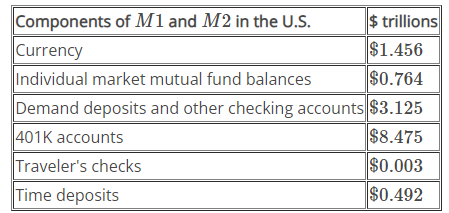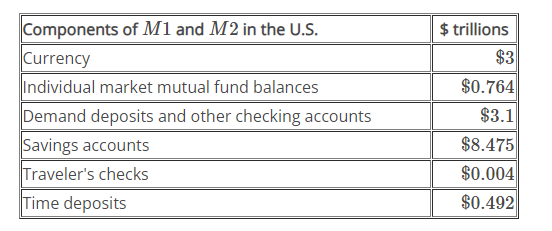14.2 Measuring Money Currency M1 and M2
1/9
There's no tags or description
Looks like no tags are added yet.
Name | Mastery | Learn | Test | Matching | Spaced |
|---|
No study sessions yet.
10 Terms
True or false?
A demand deposit is an investment option in which the deposits of many investors are pooled together and invested in a safe way.
False
A demand deposit is a checkable deposit in a bank that is available by making a cash withdrawal or writing a check.
Which of the following require the depositor to commit to leaving their investment in the bank for a certain period of time in exchange for higher interest rates?
Select the correct answer below:
money market account
demand deposit
certificate of deposit
savings deposit
certificate of deposit
Time deposits and certificate of deposit accounts are both accounts that the depositor has committed to leaving in the bank for a certain period of time in exchange for a higher rate of interest.

The table below shows the components of M1 and M2 in the U.S. Use the table to calculate Total M1. Round to the nearest third decimal place.
$13.213
M1 money supply is composed of coins and currency in circulation, checkable and savings deposits, and traveler's checks. To calculate M1, add these components together, which is equal to $13.213 trillion.

The Federal Reserve System is responsible for tracking the amounts of M1 and M2 and prepares a weekly release of information about the money supply. The table below shows the U.S. money stock components of M1 and M2. Use the table to calculate Total M1. Round to the third decimal place.
$4.582 trillion
M1 money supply is composed of coins and currency in circulation, checkable deposits, savings deposits, and traveler's checks. To calculate M1, add these components together which equals $4.584 trillion.
Examples of smart cards include _________
Select all that apply:
calling cards
debit cards
gift cards
credit cards
calling cards
gift cards
With a smart card, you can store a certain value of money on the card and then use the card to make purchases. Some “smart cards” used for specific purposes, like long-distance phone calls or making purchases at a campus bookstore and cafeteria, are not really all that smart, because you can only use them for certain purchases or in certain places.
Which of the following is part of M1? I. currency in a bank's vault II. cash in your wallet III. checkable deposits IV. traveler's checks
Select the correct answer below:
II, III, and IV
I, II, III, and IV
I, II, and III
II and III
II, III, and IV
M1 includes currency in circulation, checkable and savings deposits, and traveler's checks. M2 is a broader measure of the money supply than M1. Currency in a bank's vault would not count as M1.
Which of the following is the money supply that includes currency, checkable deposits, traveler's checks, savings deposits, money market funds, and certificates of deposit?
Select the correct answer below:
overall money supply
M0 money supply
M2 money supply
M1 money supply
M2 money supply
M1 and M2 money have several definitions, ranging from narrow to broad. M1 = coins and currency in circulation + checkable (demand) deposit + savings deposits + traveler’s checks. M2 = M1 + money market funds + certificates of deposit + other time deposits.

The Federal Reserve System is responsible for tracking the amounts of M1 and M2 and prepares a weekly release of information about the money supply. The table below shows the U.S. money stock components of M1 and M2. Use the table to calculate Total M1. Round to the third decimal place.
M1 money supply is composed of coins and currency in circulation, checkable deposits, savings deposits, and traveler's checks. To calculate M1, add these components together which is $14.579
Which of the following components are used to calculate M1? Select all that apply.
Select all that apply:
Savings accounts
Currency
Traveler's checks
Time deposits
Savings accounts
Currency
Traveler's checks
M1 money supply includes those monies that are very liquid such as cash, checkable (demand) deposits, savings deposits, and traveler’s checks.
You can store a certain amount of money on a _______ which can be used to make specific purchases at specific places.
Select the correct answer below:
debit card
smart card
credit card
None of the above
smart card
With a smart card, you can store a certain value of money on the card and then use the card to make purchases. Some “smart cards” used for specific purposes, like long-distance phone calls or making purchases at a campus bookstore and cafeteria, are not really all that smart, because you can only use them for certain purchases or in certain places.